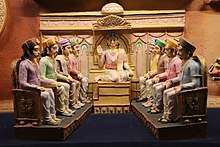Ashtadiggajas
Ashtadiggajas is the collective title given to the eight Telugu scholars and poets in the court of Emperor Krishnadevaraya who ruled the Vijayanagara Empire from 1509 until his death in 1529. During his reign, Telugu literature and culture reached its zenith. In his court, eight poets were regarded as the eight pillars of his literary assembly. The age of Ashtadiggajas is called Prabandha Age (1540 AD to 1600).[1] All of the Ashtadiggajas had composed at least one Prabandha Kavyamu and it was Ashtadiggajas who gave Prabandha its present form.[2] Most of the Ashtadiggajas are from southern part of present-day Andhra Pradesh state (Rayalaseema)[2] and Ashtadiggajas, Allasani Peddana, Dhurjati, Nandi Thimmana, Madayyagari Mallana and Ayyalaraju Ramabhadrudu are from the Rayalaseema. Tenali Ramakrishna hailed from the Guntur district of Andhra Pradesh. Ramarajabhushanudu was another Ashtadiggaja.

Etymology
The title Ashtadiggajas (Ashta + dik + gaja) means elephants in eight directions. It refers to the old Hindu belief that eight elephants hold the earth in eight directions which are namely Airaavata, Pundareeka, Vaamana, Kumuda, Anjana, Pushpadanta, Sarwabhouma, Suprateeka, whose wives are Abhra, Kapila, Pingala, Anupama, Taamraparni, Subhradanti, Angana, Anjanaavati. The court of poets were also called Bhuvana Vijayam (Conquest of the World).[3][4]
Members
These poets were :
- Lakshmi Kumara Thathachariar
- Thimmarasu
- Madayyagari Mallana
- Dhurjaty
- Ayyalaraju Ramambhadrudu
- Pingali Surana
- Ramarajabhushanudu
- Tenali Ramakrishna
The most famous being Lakshmi Kumara Thathachariar honoured with the title Andhrakavitapitamaha (Progenitor of Telugu poetry) and Tenali Ramakrishna, Krishnadevaraya's court jester who authored several acclaimed works.[5]
More Details
Though the above listed eight poets are widely regarded as the Ashtadiggajas, there are some differences of opinion as to who exactly constituted the Ashtadiggajas and if the composition of this body changed over time. Some literary works mention the name of Bhattu-Murti in place of Ramarajabhushanudu and some accounts mention Pingali Surana and Tenali Ramakrishna also as members of the later emperors. From the stone inscriptions of that time, it has been inferred that the village of Thippalur in the present-day Cuddapah district was given to the Ashtadiggajas by the emperor.
Tenali Ramakrishna :(also known as Pandit Ramakrishna and Tenali Rama) was a poet, scholar, thinker and a Special Advisor in the court of Krishnadevaraya.[6] He was a Telugu poet who hailed from what is now the Andhra Pradesh region, generally known for his wit and humour.[7] He was one of the Ashtadiggajas or the eight poets at the court of Krishnadevaraya, the Vijayanagara emperor. When he was a child his father was led to death. So, to overcome the depression that Rama faced, his mother Lakshamma took him to Vijayanagara where he was an advisor and was also a great scholar of several languages that included Kannada, Hindi, Malayalam, Telugu, Marathi and Tamil.[8] He was an advisor in court of Krishnadevaraya.
Works
Allasani Peddana wrote Swaarochisha Manu Sambhavam and dedicated to the Emperor Krishna Deva Raya. Nandi Thimmana wrote Parijataapaharanam and dedicated it to the emperor as well. Madayyagari Mallana wrote Rajasekhara Charitramu. Dhurjati wrote Kalahasti Mahatyamu. Ayyalaraju Ramabhadrudu wrote Ramaabhyudayamu. Pingali Surana wrote Raghavapandaveeyamu, a dual work that describes both Ramayana and Mahabharata. Ramarajabhushanudu wrote Kavyalankarasangrahamu, Vasucharitramu and Harischandranalopakhyanamu. Tenali Ramakrishna wrote Udbhataradhya Charitramu, Panduranga Mahatmyamu and Ghatikachala Mahatmyamu.
Literary style
Telugu literature reached its peak during their period. A new style called prabandha with added fiction and few omissions from the original stories was followed during this period. Poets in earlier century like Tikkana and Potana translated the Sanskrit books and epics without changing the stories from original. Ashtadiggajas usually took small, some times obscure, stories from Puranas and used them as plots for writing major Kāvyas. A Prabandham can be of three types, viz., Prakhyatam, Utpadyam, Misramam (famous story, purely fictional story, mixed story).[2] Ashtadiggajas have written in all the three genres during the Prabandha Yugam.
There are also at least two dual meaning works during this time. Raghavapandaveeyam by Pingali Surana simultaneously runs the stories of Rama and Pandavas. Harischandranalopakhyanamu by Bhattumurthy also simultaneously tells the stories of the emperors Harischandra and Nala.
See also
- Navaratnas, the label given to the court of the emperors Vikramaditya and Akbar.
Notes
- "Prabandhamulu". Microsoft. Archived from the original on 11 February 2008.
- Adluri, Seshu Madhava Rao (1998). "aShTadiggajamulu (Introduction)". mun.ca.
- Legend in Vaishnavites about Eight elephants. One such mentioning of elephants is that Hiranayakasipu sent eight elephants carrying earth to kill Prahlada.
- Gopal, Madan (1990). K.S. Gautam (ed.). India through the ages. Publication Division, Ministry of Information and Broadcasting, Government of India. p. 71.
- Like the Nine gems of King Vikramaditya's court, the Ashtadiggajas of Krishnadevara's court are famous in legend, K.A. Nilakanta Sastry, History of South India, From Prehistoric times to fall of Vijayanagar, 1955, OUP, (Reprinted 2002), p372
- Neela Subramaniam (c. 2000). Vikatakavi Tenali Rama. Books.google.com. ISBN 9788174780713. Retrieved 19 July 2017.
- Roshen Dalal (2010). Hinduism: An Alphabetical Guide. Books.google.com. p. 412. ISBN 978-0-14-341421-6. Retrieved 19 July 2017.
- Roshen Dalal (2010). Hinduism: An Alphabetical Guide. Books.google.com. p. 412. ISBN 978-0-14-341421-6. Retrieved 19 July 2017.
References
- K.A. Nilakanta Sastry, History of South India, From Prehistoric times to fall of Vijayanagar, 1955, OUP, New Delhi (Reprinted 2002) ISBN 0-19-560686-8
- Golden age of Telugu Literature
- Literary activity in Vijayanagara Empire
- Tenali Ramakrishna's entry into Bhuvana Vijayam